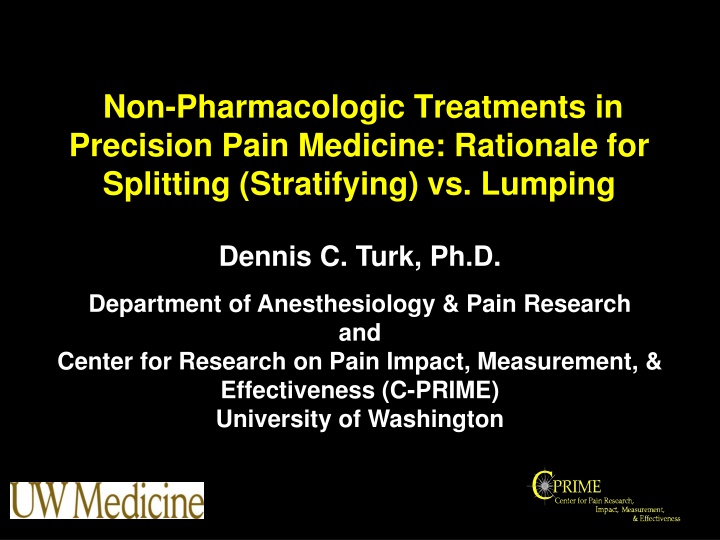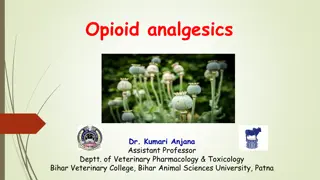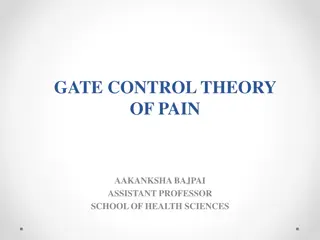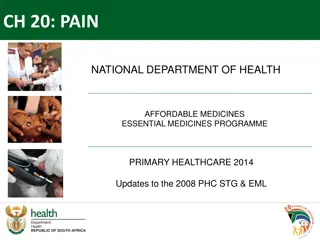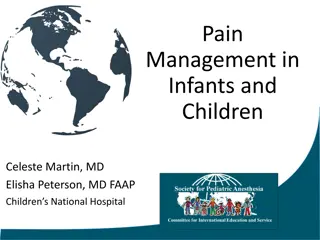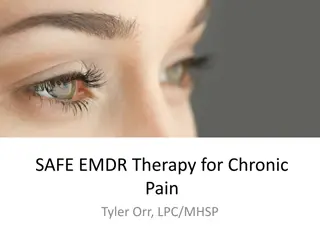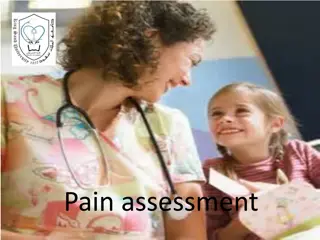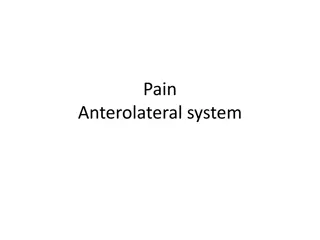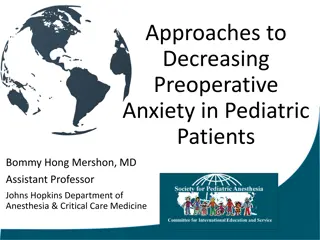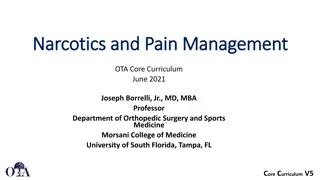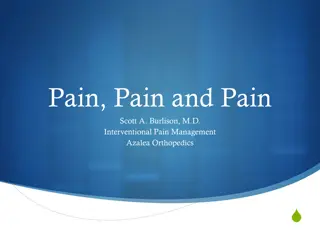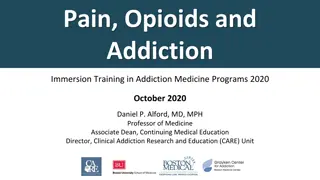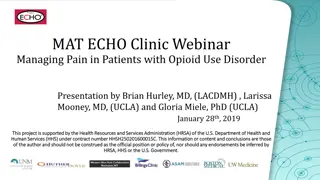Non-Pharmacologic Treatments in Precision Pain Medicine: Splitting vs. Lumping Criteria
This article discusses the rationale behind splitting (stratifying) versus lumping patients in precision pain medicine. It explores criteria for stratifying patients based on demographic, genetics, biomedical mechanisms, clinical presentation, etiological factors, and psychological response to treatment. Additionally, it provides insights into the attributed causes of symptoms in fibromyalgia patients and background information related to traumatic and idiopathic cases. Biomedical and psychosocial findings by onset in fibromyalgia patients are also featured, along with observed physical function and perceived disability by pain onset.
Download Presentation

Please find below an Image/Link to download the presentation.
The content on the website is provided AS IS for your information and personal use only. It may not be sold, licensed, or shared on other websites without obtaining consent from the author.If you encounter any issues during the download, it is possible that the publisher has removed the file from their server.
You are allowed to download the files provided on this website for personal or commercial use, subject to the condition that they are used lawfully. All files are the property of their respective owners.
The content on the website is provided AS IS for your information and personal use only. It may not be sold, licensed, or shared on other websites without obtaining consent from the author.
E N D
Presentation Transcript
Non-Pharmacologic Treatments in Precision Pain Medicine: Rationale for Splitting (Stratifying) vs. Lumping Dennis C. Turk, Ph.D. Department of Anesthesiology & Pain Research and Center for Research on Pain Impact, Measurement, & Effectiveness (C-PRIME) University of Washington
There are two kinds of people in the world those who think there are two kinds of people and those who don t. The first group can be labeled splitters, the latter lumpers.
Splitting vs. Lumping Criteria for Stratifying Patients Demographic Genetics Biomedical Mechanisms Clinical presentation (eg, symptoms) Etiological (actual or perceived) Psychological Response to treatment
Splitting vs. Lumping Criteria for Stratifying Patients Demographic Genetics Biomedical Mechanisms Clinical presentation (eg, symptoms) Etiological (actual or perceived) Psychological Response to treatment
FM: Attributed Cause of Symptoms N = 569 Accident at work = 5.9% Accident at home = 1.7% Automobile accident = 13.8% Following surgery = 5.4% Following an illness = 9.6% No identifiable cause = 39.5% Other (eg, stress) Precipitating event = 36.4% = 21.0% Robinson et al. Pain Med 2012;13:1366-76
FM Patients - Background Information Traumatic (n=46) Idiopathic (n=46) Age 50.46 (11.97) 48.46 (10.08) Sex (female) 94% 94% HS. Education 81% 93% Married 57% 66% Duration (mos.) 86.75 (98.23) 98.52 (92.28) Turk et al.J Rheumatol 1996;23:1255-62
Biomedical and Psychosocial Findings by Onset in FM Patients Traumatic Idiopathic 5 60 Ps<0.05 NS 58 Mean MEDICS T-Scores 56 4 Mean Scores 54 52 3 50 48 2 46 44 1 42 40 0 Interference Affective Biomedical Findings Pain Severity 0=none, 6 = Extremely Distress Turk et al.J Rheumatol 1996;23:1255-62
Observed Physical Function and Perceived Disability by Pain Onset Traumatic Idiopathic 56 49 52 NS 47 48 P<0.05 45 44 Mean ROM PDI Mean NDI 40 43 36 41 32 39 28 37 24 20 35 Perceived Disability Physical Function Turk et al. Pain 1996;68:423-30
Previous Treatments All Ps<0.05 90 Traumatic Idiopathic 80 Percent Prescribed 70 60 50 40 30 20 10 0 Physical Therapy Nerve Blocks TENS Opioids Turk et al. Pain 1996;68:428-30
Moderate-Severe Sx vs. Mildly Sx in Whiplash Pts: Differences on Physical Examination, Imagining, & Neuropsychological Tests (n = 108) Physical Examination CROM (degrees) (extension, flexion, lt-rt rotation, lt-rt lateral bend) Neck strength force in pounds (flexion, extension, rt-lt lateral bend) Shoulder range of motion degrees (abduction, flexion, ext-inter rotation) Shoulder strength force in pounds (abduction, flexion, ext-int rotation) Elbow (flexion-extension) Grip strength Pinch strength Plain X-rays of cervical spine No significant difference on any Neuropsychological Test Wechsler Memory Scale Trails A, B Robinson et al. Arch Phys Med Rehabil 2007; 88:774-9
Pictorial Fear of Activity Scale (PFActS-C) 78 Photographs of movements + 5 control involving lower body) Arm Position: Side, Extended at shoulder, Overhead Loading: Loaded, Unloaded Movements: Flexion, Extension, Lateral bending (Rt, Lt), Rotation (Rt, Lt) Degree: Minimal, Extreme Turket al. Pain 2008;139:55-62.
Pictorial Fear of Activity Scale (PFActS-C) Examples From Set of 78 + 5 controls Arms overhead Loaded Flexion Extreme Arms extended Unloaded Rt rotation Minimal Arms at side Unloaded Lt rotation Extreme
Hierarchical Multiple Regression of Current Symptoms Pred Var & Step R2 MPI-PS #Sx NDI MPI-PS #Sx NDI R2 Change 1. Age 2. CROM 3. TSK 4. PFActS-C 5. CESD .001 .031 .002 .001 .031 .002 .004 .035 .011 .002 .003 .009 .205 .168 .244 .201** .445 .274 .463 .240*** .106* .219*** .461 .300 .545 .017 .025 .082 .133* .233** *P<0.05, **P<0.01, ***P<0.001 CROM, cervical range of motion; TSK, Tampa Scale of Kinesiophobia; PFActS-C, Pictorial Fear of Activity Scale-Cervical; CESD, Center for Epidemiological Studies Depression Scale; MPI-PS, Multidimensional Pain Inventory-Pain Severity; NDI, Neck Disability Index Turk et al. J Pain 2004;5 (Suppl 1):124
Splitting vs. Lumping Criteria for Stratifying Patients Demographic Genetics Biomedical Mechanisms Clinical presentation (eg, symptoms) Etiological (actual or perceived) Psychological Response to treatment
Multidimensional Pain Inventory Part III Part I Part II Houshold Chores Negative Resp. Pain Severity Solicitious Resp. Interference Outdoor Work Distracting Resp. Life Control Activities Away from Home Affective Distress Social Activities Support Kerns et al. Pain 1985;23:345-56
Psychotyping -- Unique Characteristics of Subgroups of Chronic Pain Patients Based on Adaptation Dysfunctional Hi pain Hi emot distress Lo sense control Lo activity Interpersonally Distressed Lo support Lo solicitous resp Lo distract resp Hi negative resp Adaptive Copers Lo emot distress Hi sense control Hi activity Turk DC, Rudy TE. J Consult Clin Psychol 1988;56:233-8
MPI Profile Distributions CLBP1 HA1 TMD1 SLE3 MetCa4 Local Ca4 FM2 26% DYS 62% 46% 44% 14% 64% 31% 39% ID 18% 22% 26% 28% 6% 35% 20% 32% 30% 46% 31% 34% 35% AC 1Turk DC & Rudy TE. Pain 1990;43:27-36;2Turk et al. J Rheumatol 1996;23:1255-62;3Greco et al. Pain Med 2003;4:39-50;4Turk et al. Pain 1998;74:247-56
External Validation of MPI Clusters, TMD Physical Examination Variable Cluster Means DYS ID AC Sig. Pain Duration (yrs.) 4.74 5.89 5.95 ns # Sx. / Exam 1.18 1.16 1.38 ns Max. Intercisal Open (mm) 30.23 30.31 32.09 ns Prop. Abn. CTs 0.44 0.52 0.47 ns Rudy et al. Pain 1989;36:311-20
Observed Physical Functioning of Chronic Pain Patients by MPI Subgroups ID AC DYS Lumbar Flexion Fingertips to Floor Straight Leg Raise Cervical ROM 7 40 50 100 38 45 6 80 36 40 60 5 34 35 32 30 4 40 30 25 3 28 20 20 All not statistically significant Turk et al. Pain 1996;68:423-30
Psychiatric Diagnoses in MPI Subgroups Thieme et al. Psychosom Med 2004;66:837-44
Splitting vs. Lumping Criteria for Stratifying Patients Demographic Genetics Biomedical Mechanisms Clinical presentation (eg, symptoms) Etiological (actual or perceived) Psychological Response to treatment
Treatments for FM: Pharmacological Coenzyme Q10 Growth Hormone Guanethidine Interferon alpha 5-Hydroxytrptophan Moclobemide Lignocaine Pindolol Tenoxicam Tiaprofenic acid Melatonin Staph. Toxoid Tropisetron Rhus toxicodendron Gamma- Hydroxybuturate Staph toxoid Calcitonin Naltrexone Antidepressants MAO Inhibitors Moclobemide Pirlindole Tricyclics Amitriptyline Cyclobenzaprine Clomipramine Dothiepim Doxepin Tetracyclic Maprotiline Mirtazapine SSRIs Citalopram Fluoxetine Sertaline Paroxetine SNRIs Duloxetine Milnacipran Venlafaxine Opioids Morphine Tramadol + APAP Sedative/Hypnotics Sodium Oxybate Zolpiclone Zolpidem Anticonvulsants Pregbalin Pramipexole Ropinirole 5-HT3 Antagonists Ondanseron Tropisetron NMDA Antagonists Dextromethorphan Ketamine Supplements SAM-e Ginko Biloba NSAIDS Ibuprophen Naproxen Muscle relaxants Cyclobenzaprine Tizanidine Carisoprodol + Parcetamol + Caf Other Prednisone Topical Capsaicin Malic Acid + Magnesium Hydrox Antidiencephalon Immune Serum Mexillitine Myanserine Chlormezanone Delta-9-THC Alprazolam Bomazepam Last count: N = 57
Comparison of Medications for FM % pts > 50% reduction pain Medication N Tx Duration Active Placebo P value *Duloxetine1 207 12 wks 28% 17% 0.06 *Duloxetine2 354 12 wks 41% 23% 0.003 *Milnacipran3 125 12 wks 37% 14% 0.04 *Pregabalin4 528 8 wks 29% 11% 0.001 Pramipexole5 60 14 wks 42% 14% 0.008 Ropinrole6 30 14 wks 45% 30% 0.31 IArnold et al. Arthritis Rheum 2004;50:2974-84;2Wernicke et al Arthritis Rheum 2004;50(Suppl 9),S1867 (abst); 3Vitton et al. Hum Psychopharmacol Clin Exp 2004;19:S27-35;4Crofford et al Arthritis Rheum 2005;52:1264-73;5Holman A & Myers R. Arthritis Rheum 2005;52:2495- 505;6Holman. J Clin Rheum 2003;9:277-9
Patterns of Pain Reduction with Duloxetine Duloxetine Placebo Dulox Placebo Bimodal distribution, SD>Mean, thus average not appropriate Moore et al. Eur J Pain, 2013
Treatments for FM: Non-Pharmacological Acupuncture Aerobic exercise Aloe vera Anthocyanidins Autogenic training Balneotherapy Biofeedback Bioresonance therapy Chorella CBT Cryotherapy (whole body) Delta wave sleep interruption Education EEG-driven stimulation Electroacupuncture TENS ECT Manip + Ultrasound Wool Stress management Stretching exercise Sulphur mud baths Tender pt injections Written emotional expression Connective tissue manip. + ultarsound Amitriptyline + Stanger bath Massage Pool exercise + education Aquatic exercise (deep water running) Warm water exercise Transcranial Direct Current Stimulation Electromagnetic Shielding Fabric Valerian bath Feldenkrais Flexibility exercise Guided imagery Homeopathic vellum Hot Packs Hyperbaric Oxygen Hydrogalvanic therapy Hypnotherapy Laser therapy Light therapy Magnetized mattress Manual lymph drainage Marital counseling Massage, connective tissue Meditation Muscle vibration Neck support Operant conditioning Psychomotor therapy Qigong + Mindful Meditation Relaxation Last count: N = 57
Effects of Nonpharmacological Treatments - Average Expected Reduction in Pain Intensity Acupuncture CBT/Mindfulness Sleep restoration Physical fitness Hypnosis, Yoga, Manipulations some effect 10+% 30-50% 40% 60% Turk et al. Lancet 2011;337:2226-35
Treatment Protocol Outpatient, 6, 3 hour sessions, once/wk Medical educational, reassurance Physical aerobics and stretching exercises Occupational pacing, body mechanics Psychological pain and stress management Turk et al. Arthritis Care Res 1998;11:397-404
Change in the MPI Profiles Post-treatment 100 90 Posttreatment Frequency, % 38 80 70 60 50 40 30 20 10 0 AC 62 ID 80 DYS 54 15 13 23 8 7 DYS ID AC MPI Profiles Turk et al. Arthritis Care Res 1998;11:397-404
Predictors of Clinically Meaningful Response at 12 mo. Follow-up Physical Functioning (PF) & Pain Intensity (PI) Treatments (15 weekly grp sessions) Operant CBT Attention Control (n = 43) (n= 42) (n = 40) % Respond PF/PI 58.1%/53.5% 38.1%/45.2% 5.0%/7.5% High Phys Impair Pain High Pain Behav High Solict Spouse X Low Phys Funct More MD Visits High Catas High Affect Dist Low Solicit Spouse Low Pain Behav Low Coping High Neg Support X X X X X X X X X X X Thieme et al. Arthritis Care Res 2007;57:830-6
Predisposing/ Precipitating Perpetuating/ Protective Protective & Alleviating Genetics Prior stresses Prior leaning history Physical trauma Disease/ Illness Emotional trauma Symptoms Attitudes/Beliefs Meaning Coping repertoire Social support Financial resources Behavioral responses Consequences
Longitudinal vs. Cross-sectional Perspective Socioeconomic Context Life Current age Change in pathology Expectancy Change in pathology Age at pain onset Pathology Premorbid characteristics Genes Learning Hx 0 44 76+ 37 Resources Interpersonal support Economic
A question that remains to be resolved Can we improve clinical outcome by matching treatments to patients characteristics? Personalized Health Care / Precision Medicine
Arguments That Support Splitting or Typing (Geno, Pheno, Psycho) There are large variations in adaptation to disease and response to treatment. Patients with the same diagnosis respond in widely different ways. The traditional diagnostic classifications are not comprised of homogeneous sets of patients. Psychosocial factors influence adaptation independent of medical diagnosis and pathophysiology. Lack of attention to important variations has hindered our understanding and treatment of patients these reasons splitting may be essential in chronic pain; however, for
How to Split and Lump May not be a simple dichotomy of lumping or splitting but rather how to split and lump -- by Genotypes, Phenotypes, and Psychotypes vs. traditional biologically-based diagnosis (eg, fibromyalgia, chronic low back pain, depression)
No single treatment eliminates pain for all people with chronic pain . Thus, we should be considering combinations of treatments for chronic pain patients -- psychological as well as pharmacological and physical. Sometimes 1 + 1 does = 3 And these should be matched to patients taking into consideration both psychosocial ( psychotyping ) and biological characteristics. Turk DC.Clin J Pain 2001;17:281-3.
